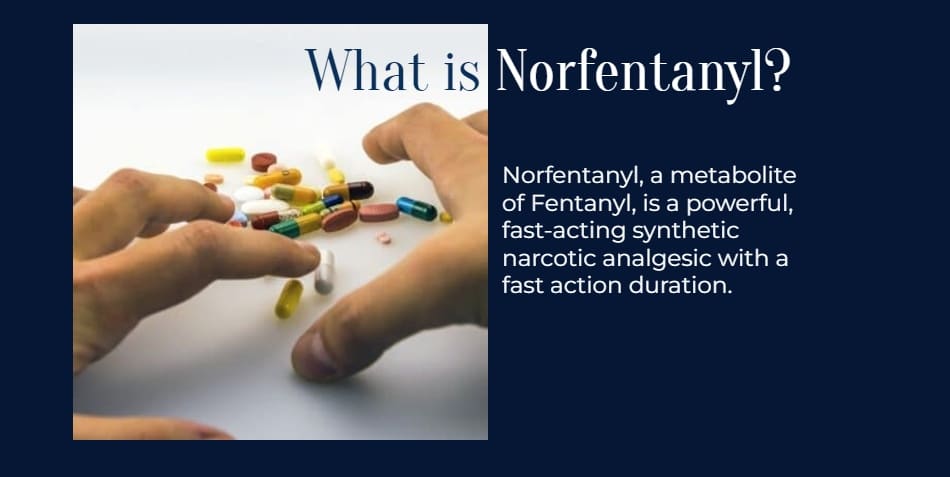What is Norfentanyl?
Overview of the compound
Norfentanyl is a metabolite of fentanyl, one of the most potent synthetic opioids used for pain management and anesthesia. It forms when fentanyl is processed in the liver, breaking down into metabolites, including Norfentanyl. This substance is not pharmacologically active, meaning it does not produce the same pain-relieving or psychoactive effects as fentanyl. However, it serves as a critical marker in drug testing, particularly in toxicology and forensic investigations.
Norfentanyl, a metabolite of fentanyl, is a powerful, fast-acting synthetic narcotic analgesic with a fast action duration. The Drug Enforcement Administration and the U.S. Department of Justice have classified Norfentanyl as a Schedule II drug. This means Norfentanyl has a high potential for abuse, leading to severe physical or psychological dependence.
Its relationship with fentanyl
Fentanyl is known for its rapid onset and high potency, making it a widely used medication in controlled environments. Unfortunately, it is also associated with significant abuse potential. Norfentanyl’s presence in biological samples indicates fentanyl exposure, either from medical use or illicit consumption. Its detection can help differentiate between therapeutic use and misuse, providing valuable insights for clinicians and law enforcement.
Importance in Medical and Forensic Fields
Detection in toxicology reports
Norfentanyl plays a crucial role in toxicology, acting as a biomarker to confirm fentanyl exposure. Laboratories often test for it in urine, blood, and other bodily fluids. Unlike fentanyl, which may quickly leave the system, Norfentanyl remains detectable for a longer duration, providing a reliable indicator of prior fentanyl use.
Role in understanding drug metabolism
Studying Norfentanyl helps researchers and medical professionals understand how fentanyl is metabolized in the body. This knowledge is vital for designing better detection methods, improving therapeutic drug monitoring, and developing treatment protocols for overdose cases.
Chemical Composition of Norfentanyl
Structural Formula
Norfentanyl’s chemical structure is distinct yet closely related to its parent compound, fentanyl. It contains key functional groups responsible for its role as a metabolite, including an altered nitrogen and carbon arrangement resulting from fentanyl’s enzymatic breakdown in the liver. This structural distinction makes it easily identifiable in laboratory testing, even when fentanyl itself is no longer detectable.
Pharmacological Significance
Although Norfentanyl lacks direct pharmacological activity, its presence is pivotal in medical and forensic applications. As a byproduct of fentanyl metabolism, it allows professionals to trace fentanyl usage and understand how the drug interacts with the body’s biological systems. These insights contribute to safer clinical applications of fentanyl and enhance diagnostic accuracy in overdose situations.
How It Is Synthesized
Natural Breakdown Process in the Body
Norfentanyl is naturally produced when the liver metabolizes fentanyl. Enzymes, particularly cytochrome P450, facilitate this process, converting fentanyl into inactive compounds like Norfentanyl and hydroxyl metabolites. This conversion occurs rapidly, with Norfentanyl often detectable in the body within hours of fentanyl administration.
Laboratory Synthesis for Research
In controlled environments, Norfentanyl can also be synthesized for research purposes. Scientists create the compound to study its chemical behavior, develop new detection technologies, and refine drug testing protocols. These efforts are essential for advancing forensic science and improving public health responses to opioid misuse.
Role in Drug Testing
Detection of Norfentanyl in the Body
Testing Methods
Detecting Norfentanyl typically involves advanced analytical techniques like gas chromatography-mass spectrometry (GC-MS) or liquid chromatography-tandem mass spectrometry (LC-MS/MS). These methods are highly sensitive, enabling the identification of even trace amounts of the compound in biological samples like blood, urine, or hair.
Sensitivity and Specificity
One of the benefits of Norfentanyl testing is its high specificity. The presence of this metabolite confirms fentanyl exposure, as it is not produced by other opioids or medications. This specificity reduces the likelihood of false positives, ensuring accurate results in both clinical and forensic settings.
Norfentanyl as a Marker for Fentanyl Use
Importance in Identifying Abuse
Norfentanyl serves as a definitive marker for fentanyl use. In cases of suspected opioid misuse, its detection can confirm whether fentanyl was consumed, helping healthcare providers design effective treatment plans for addiction or overdose.
Differentiating Between Fentanyl and Analogs
With the rise of illicit fentanyl analogs, distinguishing between substances is critical. Testing for Norfentanyl helps identify genuine fentanyl use, as most analogs do not metabolize into this specific compound. This differentiation aids law enforcement in tracing the origins of opioid-related incidents.
Medical and Forensic Implications
Monitoring for Overdose Prevention
Real-Time Detection in Healthcare Settings
In emergency healthcare settings, the ability to detect Norfentanyl quickly can save lives. By confirming fentanyl exposure, medical teams can administer appropriate treatments, such as naloxone, to counteract the drug’s effects. This capability is especially critical during the ongoing opioid epidemic, where fentanyl-related overdoses are on the rise.
Use in Overdose Diagnostics
In forensic investigations, detecting Norfentanyl in postmortem toxicology reports provides crucial evidence about the cause of death. It helps distinguish fentanyl-induced fatalities from other potential factors, offering clarity in complex cases.
Legal and Forensic Relevance
Evidence in Drug-Related Cases
Norfentanyl’s detection plays a pivotal role in drug-related legal cases. It can serve as evidence of fentanyl use, supporting claims of misuse or distribution. Forensic labs rely on Norfentanyl as a key marker when building cases against illegal opioid trafficking networks.
Role in Criminal Investigations
From overdoses to drug trafficking, Norfentanyl is a vital piece of the puzzle in criminal investigations. Its presence helps authorities establish timelines, confirm substance use, and understand patterns of abuse, strengthening their ability to combat the opioid crisis.
Risks and Challenges
Limitations of Norfentanyl Testing
Potential False Positives
While Norfentanyl testing is highly specific, no system is entirely foolproof. Cross-reactivity with other substances or errors in sample handling can occasionally lead to false positives. These challenges underscore the need for rigorous lab protocols.
Challenges in Lab Interpretation
Interpreting Norfentanyl levels in biological samples requires expertise. Variations in metabolism, the timing of sample collection, and the presence of other substances can complicate results, necessitating careful analysis by trained professionals.
Health Risks Associated with Fentanyl Use
Connection to the Opioid Epidemic
Fentanyl’s potency and availability have made it a central player in the opioid epidemic. As a metabolite, Norfentanyl reflects the scale of fentanyl consumption and its devastating consequences, including addiction and overdose deaths.
Broader Societal Impact
The widespread abuse of fentanyl and its analogs has ripple effects, straining healthcare systems and law enforcement agencies. Understanding Norfentanyl’s role in this context can inform strategies to address these challenges and reduce harm.
Future Perspectives and Research
Advances in Detection Technology
Enhanced Testing Methods
Ongoing research aims to improve the speed, accuracy, and affordability of Norfentanyl detection. Innovations like point-of-care testing devices and portable analyzers promise to make testing more accessible in various settings, from hospitals to roadside checks.
Integration with AI and Analytics
Artificial intelligence is transforming toxicology by enabling predictive analytics and pattern recognition. By combining AI with Norfentanyl data, researchers can identify trends in fentanyl use and develop targeted interventions to mitigate risks.
Implications for Public Health Policies
Strategies to Combat Opioid Misuse
Insights from Norfentanyl testing can shape public health policies aimed at reducing opioid misuse. From educational campaigns to improved access to treatment, these strategies focus on prevention and support for affected individuals.
Focus on Prevention and Education
Educating communities about the dangers of fentanyl and its metabolites is essential. Public awareness campaigns, coupled with early detection initiatives, can empower individuals to make informed choices and seek help when needed.
What is norfentanyl used for?
Norfentanyl is a chemical compound that completes the synthesis of fentanyl. Doctors have historically used them to treat breakthrough pain and as pre-operative pain relievers. Today, it is frequently used in illegal drug laboratories.
How long does norfentanyl stay in the urine?
Norfentanyl can be detected in urine up to four days after last use, according to a study. Norfentanyl was present in more significant quantities than fentanyl immediately after use. Additionally, this Schedule II drug was detected in all patients at 48 h and in 4 of 7 patients at 96 h.
How long does fentanyl stay in the urine?
Since norfentanyl is a metabolite of fentanyl, it is crucial to mention fentanyl’s duration in the body. A urine test can detect fentanyl between 24 and 72 hours after the last use. On the other hand, hair tests can detect the drug for up to three months, while blood tests can detect it between five and forty-eight hours after use, depending on the amount taken.
Which type of drug test can detect norfentanyl?
Urine, hair, and blood tests can all detect fentanyl. However, experts believe that saliva drug testing is not a viable screening substitute for detecting norfentanyl.
What’s the need for norfentanyl and fentanyl drug testing?
Nearly 92,000 people in the U.S. died from a drug-involved overdose in 2020. Fentanyl and other synthetic opioids are responsible for 56,516 of those deaths.
What makes fentanyl deadly?
By itself, fentanyl has legitimate medical uses. But since it’s a Schedule II drug, it has a high potential for abuse and misuse. As a result, patients prescribed fentanyl typically misuse the drug, which eventually leads to overdose.
Additionally, creators of illicit drugs mix fentanyl with other substances to increase their potency. Sadly, illegal drug sellers distribute these fentanyl-laden drugs as legitimate opioid prescription medications. So people who take them unknowingly ingest fentanyl.
What can cause a false positive for norfentanyl and fentanyl?
Some drugs can lead to a false positive for fentanyl. An example is Diphenhydramine, an antihistamine that is used to treat allergies, hay fever, and common cold symptoms.

Here are some of the most popular brands containing diphenhydramine:
- Advil®
- Bayer® Aspirin
- Benadryl®
- Dimetapp®
- Ivarest®
- Sominex®
- TYLENOL®
- Unisom®
- Store brands (ex. Walmart’s “Equate” store brand or CVS Health store brand)
However, you’ll only test positive for fentanyl if the drug screen detects diphenhydramine at 20,000 ng/mL. So if you’re taking any of the medications listed above, make sure that you follow your doctor’s prescription. Additionally, if you’ll be undergoing a fentanyl drug screen while taking this drug, it is best to bring your prescription and show it to the technician who will do the drug test.
Want to know more about norfentanyl and fentanyl? Visit the Ovus Medical Blog. We have a wealth of information you can benefit from.
Buy Norfentanyl Test Strips Here

Conclusion
Norfentanyl, as a key metabolite of fentanyl, holds immense significance in medical, forensic, and public health contexts. Its detection enables healthcare providers and law enforcement agencies to trace fentanyl exposure, monitor misuse, and save lives in overdose scenarios. While challenges remain, advancements in testing and research continue to enhance our understanding of this compound, paving the way for more effective responses to the opioid crisis.
FAQs
- What is the primary role of Norfentanyl in toxicology?
Norfentanyl acts as a biomarker to confirm fentanyl use, aiding in clinical diagnostics and forensic investigations. - How long does Norfentanyl stay in the body?
Its detectability varies but typically remains longer than fentanyl, depending on factors like metabolism and sample type. - Can Norfentanyl testing distinguish between medical and illicit fentanyl use?
While it confirms exposure, additional context and testing are needed to differentiate between legitimate use and abuse. - Is Norfentanyl harmful to the body?
Norfentanyl itself is not active or harmful, but its presence indicates exposure to fentanyl, which can pose significant risks. - What advancements are being made in Norfentanyl detection?
Researchers are developing faster, more precise testing methods, including portable devices and AI-powered analytics.
